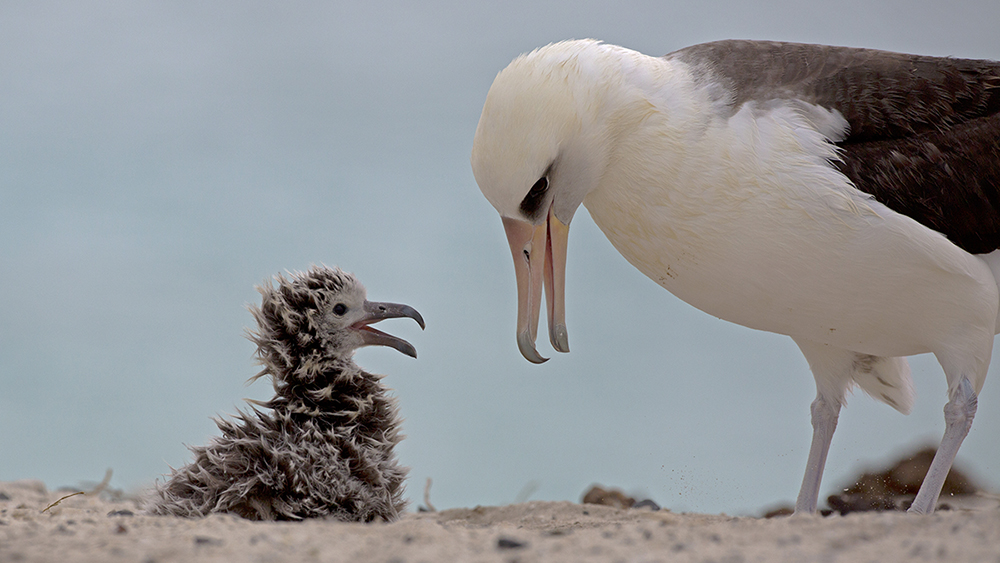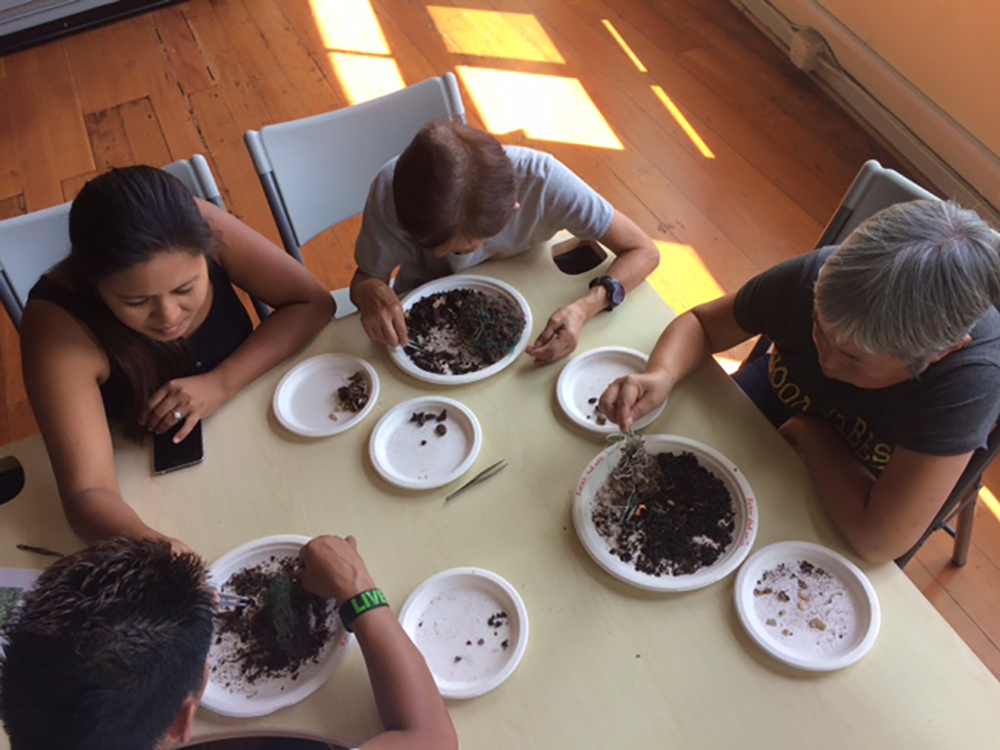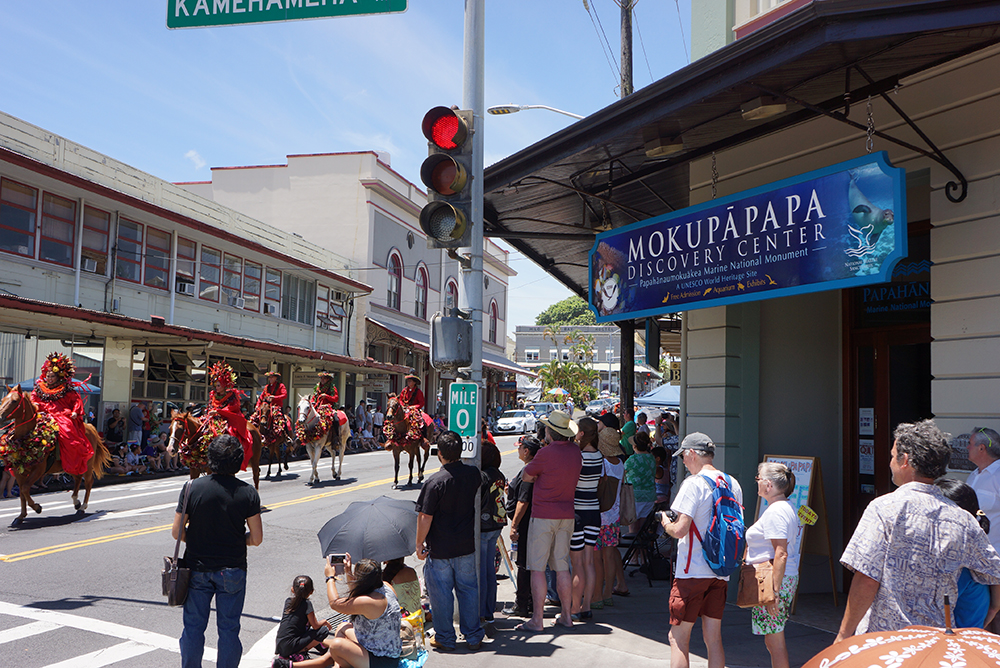Celebrating National Disability Employment Awareness Month in Sanctuaries
By Elizabeth Moore
October 2017
A bolus is the small rounded mass of food and other material coughed up by Laysan albatross chicks. Boluses are collected and dissected as a way to learn more about the diet of this wide-ranging seabird. At the Bolus Dissection Lab at the Mokupāpapa Discovery Center, they’re also used as tools to teach students and visitors about the biology, oceanography, culture, and history of the Northwestern Hawaiian Islands, protected by Papahānaumokuākea Marine National Monument. Some of those visitors are adults with developmental disabilities.

The Arc of Hilo, a nonprofit dedicated to improving the quality of life for people with developmental or other disabilities through educational, recreational, and vocational opportunities, has been working with the Discovery Center for over two years. The work that the Discovery Center does with Arc clients and other visitors with challenges is based on a simple premise: how can the Discovery Center make what they do accessible to everyone?
Bolus dissection teaches about seabird biology. It also shares lessons about the plastics found along with squid beaks and fish eggs, helping Arc clients understand why litter on the beach is so bad and how they can help solve the problem, including through beach cleanups. Watching a video about the maritime history of the Northwestern Hawaiian Islands and then building a boat from craft supplies–whether it is a high tech ROV or a traditional Polynesian voyaging canoe–is just plain fun but it also shares lessons about culture and history. Along the way, Arc clients are learning socialization and other skills to help them lead full and fulfilling lives.

According to the CDC’s National Center on Birth Defects and Developmental Disabilities, 22 percent of the adults in the United States have some form of disability. Disabilities can prevent people from enjoying the simple pleasures of traversing a beach, casting out a fishing line, or floating on a warm, sunny day. Adults living with disabilities are more likely than those with no disabilities to be inactive or overweight, smoke, and have high blood pressure, making providing access to healthy recreation and activities even more imperative.
All over the nation, communities, businesses, and individuals are taking on the challenge of making recreation accessible to all, like the programs underway at the Discovery Center. One method has been the adaptation of wheelchairs, adding bigger, wider wheels for example to allow for traversing sand and even some adapted to float in the water. These are often available free or for a rental fee at public parks and beaches all over the country. For instance, John Pennekamp Coral Reef State Park, bordering Florida Keys National Marine Sanctuary, has beach wheelchairs available for free to guests and tour boats that can accommodate wheelchairs. Bahia Honda State Park, also in the Florida Keys, includes beach access ramps, beach and floating wheelchairs, and an accessible fishing area among its amenities. Beach wheelchairs are available at numerous state parks and beaches along Monterey Bay and Greater Farallones national marine sanctuaries and other parts of the California coast.
Another way to promote accessibility is to make minor adaptations in the equipment used in water-based sports to accommodate individuals with disabilities. A pontoon like those used on outrigger canoes can help with balance in kayaking; special fishing poles, pole holders, and rods and reels can help individuals with limited mobility or strength to still enjoy feeling the play of a fish on their line. Different kinds of fins, webbed gloves, and other equipment makes scuba diving more accessible, as do different configurations of water skis for enjoying the rush of being pulled in the wake of a boat.
Organizations located all over the country offer lessons, clinics, summer camps, and events designed to help individuals with disabilities enjoy the ocean, or become or remain the athlete they always wanted to be. A “Day at the Beach” is held annually by Shared Adventures on the beaches of Santa Cruz (along Monterey Bay National Marine Sanctuary and near the Sanctuary Exploration Center), as is Operation Surf, an opportunity to surf, share and heal for wounded and disabled active and retired members of the military. Project Healing Waters helps disabled vets and active service members through fly fishing activities all over the country, including in Florida Keys National Marine Sanctuary.
Gray’s Reef National Marine Sanctuary’s 2016 film festival featured The Current, a film highlighting individuals of all abilities overcoming limitations through adaptive sports such as surfing, scuba diving, free-diving, and ocean kayaking alongside whales and dolphins in exotic locations. The film festival also included a salute to Soldiers Undertaking Disabled Scuba, an organization that offers scuba dive training for disabled veterans and active service members.

Justin Umholtz, an education specialist with the Mokupāpapa Discovery Center, speaks of one of the younger adults from the Arc who often now joins him in teaching: “He’s so gregarious and engaging, and enjoys the lessons so much, he can’t wait to share that with his friends.” This is why the Discovery Center and so many other organizations are taking on the challenge of accessibility for all. Everyone deserves an opportunity to enjoy our ocean, and national marine sanctuaries are for everyone. We will continue to work on expanding these efforts.
Elizabeth Moore is a senior policy advisor at the NOAA Office of National Marine Sanctuaries.

